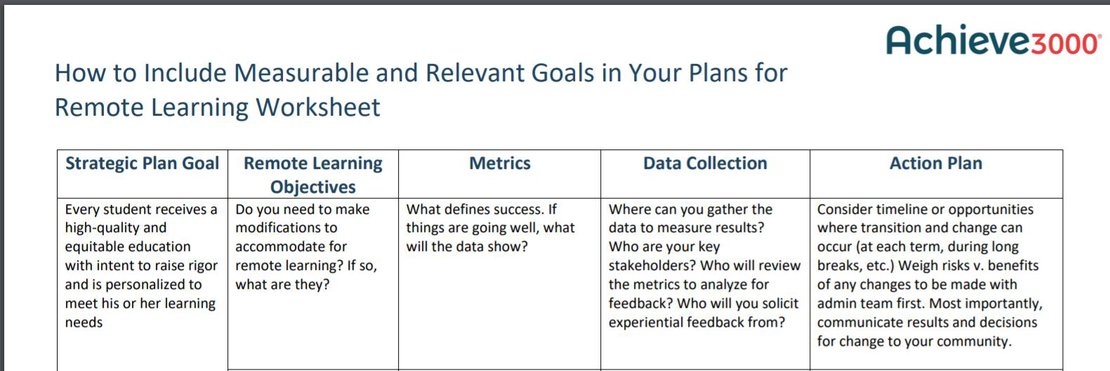One of the many challenges districts are facing as they go back to school this fall is the development of remote and distance learning plans that will allow them to define, measure, and demonstrate success for their students.
Across industries, data-driven decision making is centric for changes in practice or theory. When those data outcomes are not yet available or where decisions are reactive instead of proactive, such as during a pandemic, we have to put a plan in place that still allows those metrics to drive ongoing data-driven decisions. There is not one right approach, set of tools, or solution that will work for all schools, but these guidelines for choosing the proper metrics to evaluate remote learning plans will help ensure districts have the information needed to identify areas of improvement, celebrate successes, and make informed decisions as needed over time.
When you set out to define your overarching goals in this new remote environment, keep your Strategic Plan top of mind. In fact, you want to stay as closely aligned to your mission, vision, and values as possible, modifying your strategic direction and initiatives to accommodate only for things that simply cannot be accomplished via remote instruction and/or call for additional attention due to changing needs of students and communities, such as increased stress at home due to the pandemic. Districts who proactively plan for remote or blended programs generally spend many months organizing and aligning the new instructional model to existing district goals. When a reactive shift to remote instruction becomes the reality, taking the time to anchor your goals to your core values will help ensure your instructional strategies, tools, and accountability measures provide useful insight into where your plans are working effectively and where you may need to make future adjustments.
For example, if your strategic plan includes the goal that “Every student receives high-quality and equitable education with the intent to raise rigor and is personalized to meet his or her learning needs,” be sure to keep that as a central goal as you work to identify the new or modified strategies in your remote or hybrid environment. In this example, your new strategies might include a selection and criteria process to ensure the content and remote instructional strategies you choose for remote learning align to that key goal: being high-quality, equitable, rigorous, and including ways to personalize. Keeping those values at the core of your plans for remote learning will ensure a strong foundation firmly rooted in key community and student initiatives.
As these goals lead you to strategies in facilitating virtual instruction and supporting families, teachers, and students to navigate the transition between in-school and remote instruction, they also become a guide to measure success and a way to determine a need for revision. One mistake you want to avoid, especially in such a quickly transpired new instructional model, is being afraid to make changes throughout the year. Rather, be sure to leverage measurable data for success, gather stakeholder feedback and evaluate effectiveness to determine adjustments that need to be made. Remember that your stakeholders include parents and students in addition to teachers and staff, and the collaboration among all of these groups is vital to their comfort with change throughout the year and their ability to see themselves as partners in success and improvement.
This worksheet provides you with ideas for measuring success and identifying the areas in which improvements can be made and when. Remember, don’t wait for the end of the year. This opportunity for evaluation and measuring data should be continuous and should provide stakeholders a forum that is ongoing. Once a red-flag or potential risk are identified, don’t wait; begin the work to create an action plan.

While education technology brings many new opportunities for connecting with and meeting the needs of students, it has also been disruptive for teachers as they attempt to adjust instructional strategies they have developed over years of in-class instruction to a remote environment. For many years, teachers have been encouraged to leverage technology in education in a variety of ways, ranging from a simple replacement of a task with new digital tools to complete transformation of new tasks that were never available prior to technology. The SAMR model, a framework created by Dr. Ruben Puentedura, has become a guide as many eager teachers consider how to incorporate technology in their existing classroom models. While that model has helped to guide teachers in implementing technology in their existing classrooms, making the shift to technology-enabled instruction in a virtual environment requires a deeper level of learning for all teachers. Therefore, faculty members for most districts are likely to have a wide range of proficiency with comfort in technology and with the shift to new instructional practices.
Since this shift to a new instructional model will have a varying learning curve from teacher to teacher, taking the approach of personalized learning will be key to promoting quality professional learning and accelerated skill development in your staff. Andragogy, the method and practice of teaching adult learners, suggests we should aim to support adult learners by creating learning experiences that are relevant, allow for self-agency, and the opportunity to connect new ideas to their prior experiences.
The following best practices can be used to ensure better outcomes and a personalized approach that will enable your teachers to provide a consistent level of opportunity for all students: